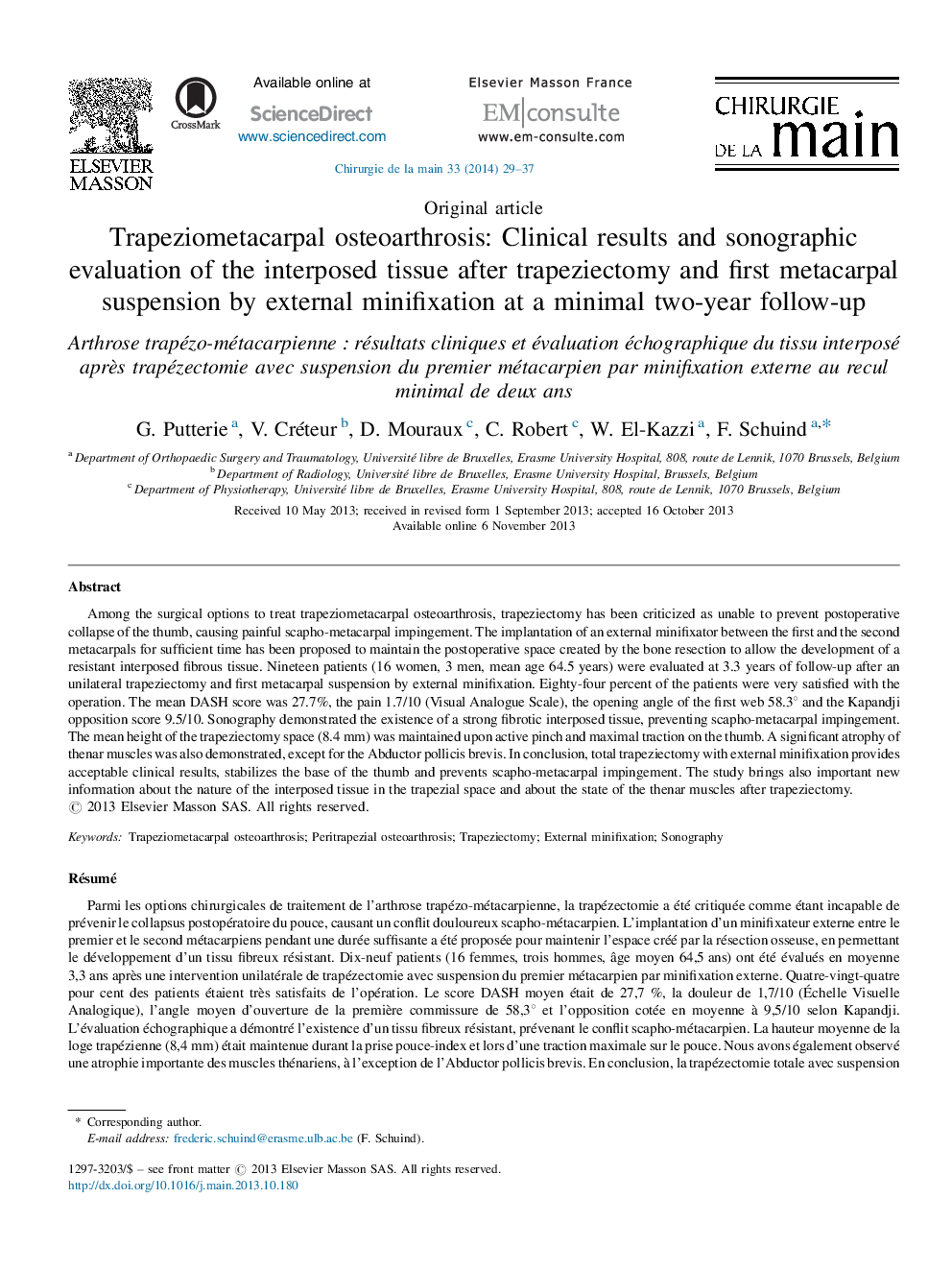| کد مقاله | کد نشریه | سال انتشار | مقاله انگلیسی | نسخه تمام متن |
|---|---|---|---|---|
| 4049070 | 1264821 | 2014 | 9 صفحه PDF | دانلود رایگان |
Among the surgical options to treat trapeziometacarpal osteoarthrosis, trapeziectomy has been criticized as unable to prevent postoperative collapse of the thumb, causing painful scapho-metacarpal impingement. The implantation of an external minifixator between the first and the second metacarpals for sufficient time has been proposed to maintain the postoperative space created by the bone resection to allow the development of a resistant interposed fibrous tissue. Nineteen patients (16 women, 3 men, mean age 64.5 years) were evaluated at 3.3 years of follow-up after an unilateral trapeziectomy and first metacarpal suspension by external minifixation. Eighty-four percent of the patients were very satisfied with the operation. The mean DASH score was 27.7%, the pain 1.7/10 (Visual Analogue Scale), the opening angle of the first web 58.3° and the Kapandji opposition score 9.5/10. Sonography demonstrated the existence of a strong fibrotic interposed tissue, preventing scapho-metacarpal impingement. The mean height of the trapeziectomy space (8.4 mm) was maintained upon active pinch and maximal traction on the thumb. A significant atrophy of thenar muscles was also demonstrated, except for the Abductor pollicis brevis. In conclusion, total trapeziectomy with external minifixation provides acceptable clinical results, stabilizes the base of the thumb and prevents scapho-metacarpal impingement. The study brings also important new information about the nature of the interposed tissue in the trapezial space and about the state of the thenar muscles after trapeziectomy.
RésuméParmi les options chirurgicales de traitement de l’arthrose trapézo-métacarpienne, la trapézectomie a été critiquée comme étant incapable de prévenir le collapsus postopératoire du pouce, causant un conflit douloureux scapho-métacarpien. L’implantation d’un minifixateur externe entre le premier et le second métacarpiens pendant une durée suffisante a été proposée pour maintenir l’espace créé par la résection osseuse, en permettant le développement d’un tissu fibreux résistant. Dix-neuf patients (16 femmes, trois hommes, âge moyen 64,5 ans) ont été évalués en moyenne 3,3 ans après une intervention unilatérale de trapézectomie avec suspension du premier métacarpien par minifixation externe. Quatre-vingt-quatre pour cent des patients étaient très satisfaits de l’opération. Le score DASH moyen était de 27,7 %, la douleur de 1,7/10 (Échelle Visuelle Analogique), l’angle moyen d’ouverture de la première commissure de 58,3° et l’opposition cotée en moyenne à 9,5/10 selon Kapandji. L’évaluation échographique a démontré l’existence d’un tissu fibreux résistant, prévenant le conflit scapho-métacarpien. La hauteur moyenne de la loge trapézienne (8,4 mm) était maintenue durant la prise pouce-index et lors d’une traction maximale sur le pouce. Nous avons également observé une atrophie importante des muscles thénariens, à l’exception de l’Abductor pollicis brevis. En conclusion, la trapézectomie totale avec suspension par minifixateur externe est une opération offrant des résultats cliniques acceptables, permettant de stabiliser la base du pouce et de prévenir le conflit scapho-métacarpien. L’étude apporte également des informations nouvelles importantes sur la nature du tissu interposé dans la loge de résection osseuse et sur l’état des muscles thénariens après trapézectomie.
Journal: Chirurgie de la Main - Volume 33, Issue 1, February 2014, Pages 29–37
